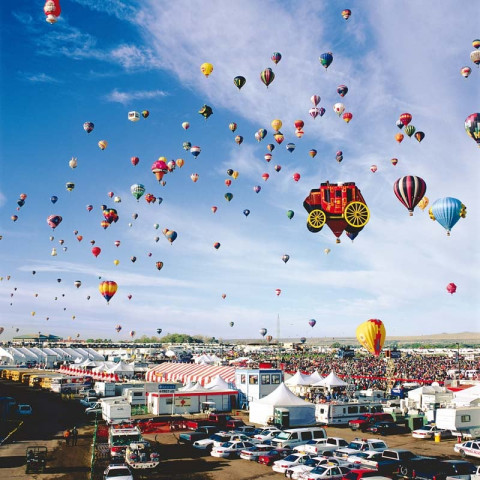International Balloon Fiesta: Hot pursuit
New Mexico’s annual ballooning fiesta attracts thousands from all over the world

 Visitors at the Balloon Museum climb into this hot-air balloon basket for a fantastic photo opportunity. PHOTO: MM ALAM
Visitors at the Balloon Museum climb into this hot-air balloon basket for a fantastic photo opportunity. PHOTO: MM ALAM You become a pilot by ‘flying’ this balloon flight simulator. PHOTO: MM ALAM
You become a pilot by ‘flying’ this balloon flight simulator. PHOTO: MM ALAMAlbuquerque hosted the first World Hot-Air Balloon Championship in 1973 and over the decades the Fiesta became a global event. In order to maintain quality, the organisers at present only allow half of the over 1,000 aspirants to participate. On any given day during the festival, up to 100,000 spectators may be on the launch field, where they happily grab at the opportunity to observe inflation and take-off procedures. Countless enthusiasts gather at landing sites all over the city to monitor incoming balloons. Many residents watch from the comfort of their backyards and painters take hold of their palette to capture the colourful affair.
The Fiesta comprises several events. As part of the Flight of the Nations event, balloonists from each nation launch their balloons, one at a time to their national anthem, while waving their flag. Mass Ascensions is the biggest event of the Fiesta, coordinated by ‘zebras’ (nicknamed owing to their outfit), ensuring that balloons leave the field in a safe and synchronised manner. For the Fiesta Challenge, balloonists attempt to drop a marker closest to a target. In America’s Challenge Gas Balloon Race, special long-distance balloons are inflated and launched. Since the one who travels the farthest is the winner, many have gone as far as Canada and the East Coast in the US. A large number of static balloons are even illuminated at night by means of their propane burners during the Fiesta.
New Mexicans say that missing a scenic balloon ride here is like going to Paris and not seeing the Eiffel Tower. During the year, many hop on board the balloons on occasions like birthdays, anniversaries, proposals and weddings. Clear blue skies, calm winds and mild temperatures enable hundreds of resident balloonists to fly for long periods of time throughout the year.
The world’s premier balloon museum
Just adjacent to the Fiesta Park is a purpose-built museum, the Anderson-Abruzzo Albuquerque International Balloon Museum, featuring a spectacular view of the Sandia Mountains. It becomes the focal point for the duration of International Balloon Fiesta. The museum is named after local pilots Maxie Anderson and Ben Abruzzo, who pioneered long-distance helium balloon flight and were part of the crews who first successfully crossed the Atlantic Ocean in a balloon in 1978 and the Pacific Ocean in 1981.
 A retired hot-air balloon is on display to help visitors learn more about ballooning equipment. PHOTO: MM ALAM
A retired hot-air balloon is on display to help visitors learn more about ballooning equipment. PHOTO: MM ALAM Three around-the-world flights were attempted in the Jules Verne gas balloon, now suspended in the museum’s Grand Hall. PHOTO: MM ALAM
Three around-the-world flights were attempted in the Jules Verne gas balloon, now suspended in the museum’s Grand Hall. PHOTO: MM ALAMBesides celebrating the accomplishments of New Mexico balloonists, the Museum is by and large dedicated to the history, science, sports, arts and spectacle of ballooning. The facility — a must-stop for any balloon enthusiast — was opened in 2005 and features one of the finest collections of ballooning equipment and memorabilia in the world, including the original gondola from the Double Eagle V which is the first manned balloon to cross the Pacific Ocean.
To enlighten visitors, an elderly volunteer at the museum with a number of medals and badges on his jacket explains the nuance in the art of ballooning. A gas balloon, for instance, can fly farther, higher and longer than hot-air balloons. “Helium and hydrogen are the most commonly used lifting gases in balloons,” he says. “Balloonists descend by letting some of the gas out through a valve at the top of the balloon.” During the day, gas is heated by the sun, making the balloon rise higher, while at night, the gas cools off and pilots drop weight (usually sand or water), called ballasts, to keep from losing altitude, he adds. Explaining why hot air balloons are so big, he says, each cubic foot of air in a hot-air balloon can lift only seven grammes. “To lift 500kgs you need about 65,000 cubic feet of hot air. Pilots use a propane burner attached to the basket, under the open balloon envelope, to reheat the air to keep the balloon aloft.”
 An average hot-air balloon is 10,000 to 90,000 cubic feet in volume. PHOTO COURTESY: MARBLESTREETSTUDIO.COM
An average hot-air balloon is 10,000 to 90,000 cubic feet in volume. PHOTO COURTESY: MARBLESTREETSTUDIO.COM Aficionados grab at the rare opportunity to observe take-off. PHOTO COURTESY: MARBLESTREETSTUDIO.COM
Aficionados grab at the rare opportunity to observe take-off. PHOTO COURTESY: MARBLESTREETSTUDIO.COMAfter a lesson in flying, on your way out, don’t forget to pick out a special balloon-themed memorabilia from the museum’s gift shop to remind you of your high adventure in New Mexico.
MM ALAM is a Karachi-based freelance journalist.
Published in The Express Tribune, Sunday Magazine, July 19th, 2015.



















COMMENTS
Comments are moderated and generally will be posted if they are on-topic and not abusive.
For more information, please see our Comments FAQ